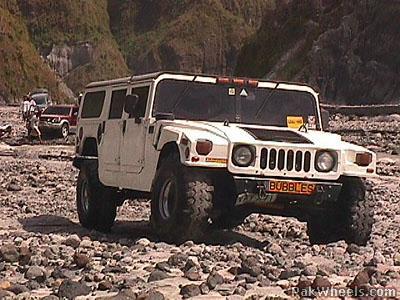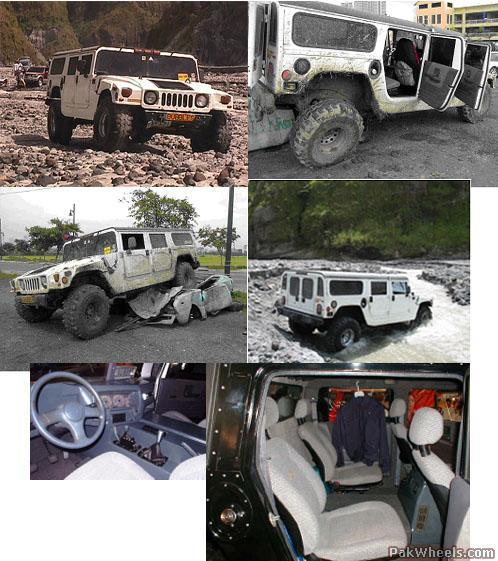i know this is old, but most of us might have missed this i guess ...........
Full Review: AMC Hammer
Hummer image without the Hummer price tag.
by Otep Rivera; 29 June 2003

We are sitting in the cockpit of the Yellow AMC Hammer while parked in a posh village along Katipunan Avenue when an Expedition pulls up alongside, and the driver asks us: “Is that for real?� We merely smile. I guess that is one of the best compliments you can give the AMC Hammer. It looks so close to the real deal (and five times more expensive) AM General Hummer that most people can’t even tell which is which by simply eyeballing the exterior… something that can’t be said for the other locally-manufactured Hummer replicas whose quality and proportions are truly comical even when compared to the locally-made AMC Hammer.
Alana Motors Corporation has been in the vehicle-assembly business for three generations now. They manufacture everything from Mini Cruisers to AUV’s. And now, the latest addition to their product line up is the Hammer. AMC may be a cottage industry manufacturer but they are now a premium cottage industry manufacturer in the tradition of those small sports-car firms in Europe.
An AMC Hammer is not a mish-mash of various parts from an assortment of manufacturers. Almost all Hammers are built on a Nissan Patrol chassis (including the frame, suspension, brakes, and other systems) using the proper Patrol drivetrain (engine, transmission, and transfer case) for that chassis. Leaf-sprung models use the SD33 3.3-liter turbodiesel inline-6 while the more expensive coil-sprung models, like our test vehicle, use the TD42 4.2-liter normally-aspirated diesel six-banger. Most of the donor drivetrains and chassis come from ex-JDM (Japanese Domestic Market) Patrols, but you can provide your own matching donor drivetrain and chassis to AMC and they will build a Hammer around it. You know, just in case you have a spare 80-series Land Cruiser you’ve gotten bored with.
Externally, the Hammer shares almost every styling element with the Hummer. Everything seems to have been designed by someone with only a ruler and a pencil to work with, making it all look and feel robust. The doors slam with authority and don’t rattle on the road. The engine cover, which tilts forward as in the genuine Hummer, is heavy and substantial. Thoughtfully, the steel grille on the engine cover lifts up for routine maintenance and fluid checks. The tow loops on the engine cover, although not load-rated by AMC, are mounted directly to the chassis frame rails and are more than cosmetic add-ons. They will take quite a load if the huge front and rear tow loops are insufficient, in the unlikely event that you get this Patrol-derived brute hopelessly stuck off-road. Unlike the Hummer, which uses fiberglass on some key components, the Hammer is all steel, employing gauge-18 and guage-21 alloy for that tough skin. Visual clues that tell you what you are looking at is in fact a Hammer and not a Hummer include the six-slot grille instead of the trademark seven, generic marker lamps, Ssangyong-Korando-sourced taillamps, and of course, the front and rear live axles. The Hammer is also substantially narrower by about eight inches, but you would never know that unless you took a tape measure to them both.
The TD42 engine of the Hammer we tested peaks at 115 horsepower at 4,000 rpm. A Honda Civic has more power than that. Unlike the Honda, however, the Hammer’s engine will have all of its 195 lb-ft of torque available at 2,000 rpm. This thing pulls like a freight train from a standing start, which allows you to easily keep up with traffic. This engine is more akin to a Mack truck’s than to your average SUV’s. It has two oil filters, a timing chain system, and a water separator. And just like in the original Hummer, the engine draws air via a snorkel at the base of the windshield. AMC upgrades this engine with a larger-capacity five-row radiator and an additional electric cooling fan to cope with the increased loads and harsher conditions Hammers are designed to withstand.
Steering is via a recirculating-ball system with standard power assist which provides decent feel. A sports car this isn’t, and the wheel feels slow -- perfect for trail work. The standard five-speed manual transmission (a four-speed automatic is optional) drives decently enough but can become balky and stubborn during quick gearchanges. Part of the blame could be the fabricated linkages AMC uses and the inherent notchiness of the Nissan gearbox. Running changes are being done at the factory regarding this matter. The Hammer uses four-wheel ventilated-disc brakes on all four wheels with no ABS or other electronic assistance. It does a pretty admirable job of stopping the more-than-two-ton beast even from extra-legal speeds. Pedal feel is good enough and there is not much fade even after repeated stops.
The Hammer has solid axles suspended by coil springs on both ends, with the front being located by three links and the rear, by five links. Stabilizer bars are standard equipment. The settings are quite soft allowing for a good deal of body roll when the Hammer is driven hard. But then again, the Hammer is no Miata and the soft calibration really helps give it a good ride both on and off pavement. Standard tires are 33x12.5R15’s mounted on painted steel rims. But 35x12.5R15 tires on chrome rims are the most popular option. Monster 38-inch tires can also be fitted (these are even larger than the original Hummer’s 37-inch tires).

Inside, there are four captain’s chairs just as in the Hummer and a huge center console that doubles as a table, or a casket. The dashboard and center console are constructed out of metal and is painted in a low gloss finish giving it a tough, business-like look. Door panels are finished in a vinyl-cloth combination that have a quality feel to them. The fuzzy carpeting used on the floor and ceiling is even better-looking than the ‘mouse fur’ used on most modern cars today. There are separate air-conditioning ducts for front and rear passengers (though both share the same controls), and all seats are fitted with 3-point ELR safety belts as standard equipment. Convenience items such as map lamps, grab handles, and ash trays are standard as well. The plastics are still not up to Japanese specs but they look good enough. The interior of the Hammer can be customized to the owner’s desires (and budget), though the standard interior is far from bare bones. About the only things lacking are a sound system and power windows (both are optional, however).
Driving the Hammer takes some getting used to. The sheer size of the machine will limit where you can go and where you can park. But this handicap is not exclusive to the Hammer alone and you will get over it after some time. What you will really need some getting used with is the instant celebrity status you acquire while behind the wheel of this behemoth. Be prepared for stares, waves, and thumbs-ups from complete strangers as you drive by. Even the traffic cops will give you preferential treatment if you are in a Hammer. Though maybe not the NPA.
Off-road is where this machine really shines. The Nissan Patrol four wheel drive system uses a hybrid front-hub lock system which can be shifted on-the-fly or manually locked by using the lug wrench for extended 4x4 use. The approach and departure angles are superb and the ground clearance is more than adequate for anything you can throw at it. And just as in the Patrol, the transmission and engine are located high up between the frame rails for protection. The 95-liter fuel tank is also located high and is protected by a dedicated steel skidplate. The Hammer does not have locking differentials, or even a limited-slip, but the aggressive mud tires usually have enough traction for the job. An optional matte-paint finish (think spray-on bedliner) ensures that your Hammer will never get scratched while you enjoy it on the trail.
Prices for the Hammer starts at P648,000 for a pick-up model using a leaf spring chassis with an SD33 turbo engine. P788,000 gets you a wagon with a coil spring chassis and a TD42 engine. Various options (winch, roof racks, roof lamps, fancy sound systems, etc.) can easily inflate the price but you will still never go near the five-million-peso price tag of the original Hummer.
If you’re the extroverted type of person who loves the outdoors and enjoys big toys, the AMC Hammer is for you. Granted that the vehicle still has some minor flaws to be worked out, nevertheless, three generations of vehicle assembly experience has really done the Alana family a lot of good in terms of the final product. This is the best locally assembled Hummer replica to date. Just ask the Expedition driver.
Full Specifications
Vehicle type front-engine, rear/4-wheel-drive, 4-passenger, 5-door wagon
Vehicle price, as tested P788,000
Engine type Nissan TD42, 12-valve inline-6 OHV mechanically-fuel-injected naturally-aspirated diesel
Displacement 4169 cc (254 cu in.)
Bore x stroke 96.0 x 96.0 mm (3.80 x 3.80 in.)
Compression ratio 22.7 : 1
Max. Power 115 bhp @ 4,000 rpm
Max. Torque 195 lb-ft (264 Nm) @ 2,000 rpm
Redline 4800 rpm
Recommended fuel octane rating diesel
Weight/power ratio abysmal
Transmission 5-speed manual
Four-wheel-drive type Dual-range lever-actuated part-time, manually-lockable automatically-locking front hubs
Transfer case ratio High: 1.00:1 / Low: 2.02:1
Final drive 3.33; front: open / rear: open
Gear ratios (Overall ratio), kph/1000 rpm
1 4.556 (15.17) na
2 2.625 (8.74) na
3 1.518 (5.05) na
4 1.000 (3.33) na
5 0.836 (2.78) na
Reverse na
rpm @ 60 kph, top gear na
rpm @ 100 kph, top gear na
Dimensions (LxWxH) 184.5 x 78.5 x 75.0 in. (4686 x 1994 x 1905 mm)
Wheelbase 116.9 in (2969 mm)
Track, F/R 62.2 in / 62.4 in (1580 / 1585 mm)
Min. ground clearance 10.7 in (272 mm)
Curb weight considerable
Payload quite a bit
Fuel capacity 95.0 L
Approach/Departure angles fantastic / amazing
Ramp breakover angle astounding
Alternator capacity na
Rated max. wading depth Not officially rated
Air intake placement base of windshield
ECU placement what ECU?
Chassis type full-length ladder-frame
Front suspension rigid axle located by three links, coil springs, anti-roll bar
Rear suspension rigid axle located by five links, coil springs, anti-roll bar
Steering type recirculating-ball, power assisted
Turns, lock-to-lock approx. 3.5
Turning circle 44.0 ft. (13.4 m)
Front brakes ventilated disc
Rear brakes ventilated disc
Parking brake hand-operated on propeller shaft
Towing capacity:
Unbraked Trailer: not officially rated
Braked Trailer: not officially rated
Fuel economy, as tested:
City: na
Highway: na
Wheels 10.0 x 15, steel
Tires General Grabber M/T, 35 x 12.5R-15
Spare none
Warranty negotiable
Service intervals 5,000 km / 6 months
Summary of major features Nissan GQ Patrol heart and bones, fearsome and intimidating body, four bucket seats, interior parts from various donor vehicles, air-conditioning system